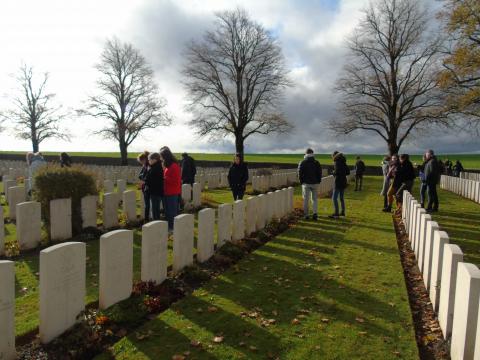
Seconde students visit the sites and memorials of the Somme battlefields.
The Seconde students spent a cold, windy day touring the First World War battlefields of the Somme in the Picardy region of Northern France to learn about the battles that took place during the offensive on the Western Front and the men who fought them, and visit the cemeteries and memorials erected after the Great War to remember the fallen on all sides of the conflict. Accompanied by two guides, the students visited:
- Serre cemetery (Serre Road N° 2), with over 7,000 burials, nearly 5,000 of which are unidentified, making it the cemetery with the largest number of unidentified burials on the Somme;
- the Ulster Tower, a replica of St Helen's Tower in Belfast, one of the last landmarks that the men of the 36th (Ulster, Northern Ireland) Division saw as they left home, and who attacked the heavily fortified German position Schwaben Redoubt on 1st July 1916, suffering heavy casualities;
- the Newfoundland Memorial Park, near Beaumont Hamel, a memorial to the Newfoundland Regiment, part of the 29th Division, which suffered appalling losses on 1st July 1916. Today it is a Canadian National Historic Monument and one of the largest areas on the Western Front where the ground has been undisturbed since the end of the First World War; the students were able to see first-hand evidence of battle including the battle lines, shell holes, barbed wire pickets and to walk through the trenches; and
- the Thiepval Franco-British memorial, which commemorates more than 72,000 men of British and South African forces who died on the Somme before 20 March 1918 and have no known grave, the majority of whom died during the Somme offensives of 1916. It stands on the high ground overlooking the River Ancre, where some of the heaviest fighting of the First World War took place. Here the students laid a wreath to the fallen during a reading of Laurence Binyon's poem, 'For the Fallen'.
A fascinating (albeit cold!) and moving day for all.
